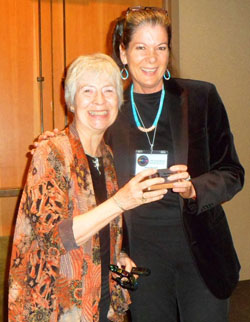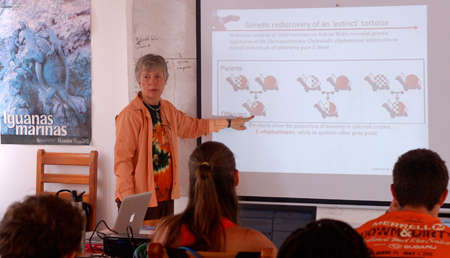Kathryn Tosney Awarded 2015
Viktor Hamburger Outstanding Educator Prize
By Marsha E. Lucas
|
 |
|
Tosney (left) receiving Hamburger Prize
from Diana Darnell, SDB Professional
Development and Education Committee
Chair at SDB 74th Annual Meeting in
Snowbird, Utah. |
The 2015 Society for Developmental Biology
Viktor
Hamburger Outstanding Educator Prize was presented
to
Kathryn Tosney of the University of Miami for her
outstanding contributions to developmental biology
education. Tosney, best known for her generously
donated scanning electron micrographs of chick
neurulation which have been published in hundreds of
biology textbooks and reviews, is a pioneer of
experiential learning. She created
The Origami
Embryo, an active-learning exercise about
morphogenesis and designed
aCross Development, a
crossword puzzle study guide to accompany Scott
Gilbert’s Developmental Biology textbook. As a
member of the SDB Professional Development and
Education Committee, Tosney worked tirelessly for
inclusion, progressive ideas, and quality in
education sessions. She served on the SDB Board of
Directors as both Midwest Representative (1996
-1999) and Treasurer (1999-2002).
In an interview last Spring, Tosney expressed her
appreciation for being awarded the Hamburger Prize.
"It is such [an] honor because it construes
educational excellence in the broadest sense that
happily coincides with my passion for teaching both
science and professional skills."
"I am truly gratified that the dual principles of
educational excellence and community support are
rewarded by my professional society."
Tosney’s developmental biology journey began while
an undergraduate at the University of Oregon where
she encountered neural crest biologist,
James
Weston. “I actually took his graduate course on
neural crest and fell in love with it,” Tosney said.
“At the time I wanted to be a molecular biologist
with Frank Stahl [of the
Meselson–Stahl
experiment],” she said. “Then, unfortunately, I
walked into Jim Weston’s lab and I saw the embryo.”
It was the beauty of the embryo that had Tosney
hooked. And thanks to Weston, she acquired a passion
for neural crest which she carried with her to
graduate school in 1975.
Tosney chose to attend Stanford University in order
to work with
Norman Wessells, chair of the biology
department and owner of a much-envied,
top-of-the-line scanning electron microscope. This
technology was key to Tosney’s work examining neural
crest cell behavior and migration in the chick
embryo. “Sometimes just looking is the most
important thing you can do,” she said.
Many of Tosney’s famous images of the neural crest,
neural tube, and somites were generated while in
graduate school, first appearing in Wessells’ own
textbook
Tissue Interactions and Development in
1977.
In 1980, Tosney joined
Lynn Landmesser's lab at Yale
University as a postdoc to study axon pathfinding in
the chick embryo. Tosney described this period as a
"joyful time of true intellectual exchange." She
valued the collaborative relationship she shared
with Landmesser so much so that when she started her
own lab at the University of Michigan in 1984, she
sought to engage her students in a similar way.
At Michigan, Tosney continued her work on axon
guidance cues in the vertebrate embryo while
dabbling in side projects on the neural crest.
Within five years she was tenured, something five of
her friends at other institutions had failed to
achieve.
"That experience made me look harder at the tenure
process," Tosney said. "And I now give this talk
across the nation called Survival in Academia."
Fortunately, her friends remained in science and
have since gone on to have long careers.
Tosney stressed the importance of having mentors at
all stages of your career.
Kate Barald, a colleague
at the University of Michigan, was a huge influence
on her scientific career. Barald was a postdoc at
Stanford when Tosney was a student. She provided
Tosney guidance and support throughout each of her
career transitions.
 Tosney's desire to help others led her to conduct
professional development workshops on life in
academia, implicit bias, scientific writing, and
creating effective posters. "It is always gratifying
to bring people skills and strategies that can help
them succeed," she said. Tosney's desire to help others led her to conduct
professional development workshops on life in
academia, implicit bias, scientific writing, and
creating effective posters. "It is always gratifying
to bring people skills and strategies that can help
them succeed," she said.
After twenty years at Michigan, Tosney headed south
to the University of Miami to become Chair of the
Department of Biology. When she arrived, she noticed
there were still some science departments that had
few or no women faculty.
In response to this she initiated the
Scientists and
Engineers Expanding Diversity and Success (SEEDS)
career development program that was initially funded
by a
National Science Foundation
ADVANCE grant for Women
in Science . The successful program is now
institutionalized in the academic affairs office of
the University of Miami to foster career success in
all departments throughout the campus.
In order to build a successful program, Tosney said
you have to "build the groundwork and the leadership
as you go so the program will continue to thrive
after you leave."
When asked to reflect on her career, Tosney said,
"the most rewarding part has been the diversity. I
was able to follow my passion and periodically
reinvent myself in significant ways. In the last 5
years, I have reinvented myself to study the
behavioral ecology of marine iguanas."
Tosney had always been interested in reptiles and
lizards, so she developed a study abroad program
with
Intercultural Outreach Initiative.
"This work has resulted in my leading a successful
conservation program in the Galapagos that preserves
the only viable population of baby marine iguanas in
Southeast Isla Isabela."
Tosney recently stepped down as Chair of her
department, but she has no plans to retire.
"I have marine iguanas to look at," she said.
|